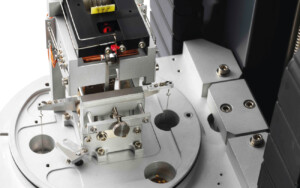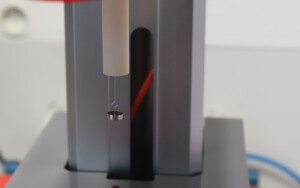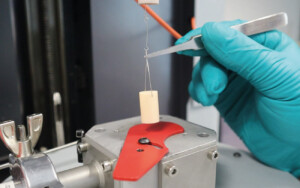An overview of Thermogravimetric Analysis and of Thermobalances
Thermogravimetric analysis measures the thermal stability of materials, and provides information on their reactivity or composition. It is sometimes referred to as TGA.

TGA – Introduction to Thermogravimetric Analysis
Thermogravimetric analysis is a thermal analysis technique based on the measurement of mass variation of a material sample while it is exposed to a given temperature or to a temperature variation program. The instrument that allows these measurements is called a thermobalance or a TGA (Thermogravimetric Analyzer).
The thermobalance is mainly composed of :
- A balance capable of continuously measuring the mass variation of the sample with respect to its initial mass. The measured variations being often very weak, one generally speaks about microbalance.
- An oven, in which the sample is placed during the experiment. This oven is equipped with a temperature control system that enables heating, cooling, and maintaining the sample temperature, following a user-programmed profile.
- A gas management system for controlling the composition and the regeneration of the atmosphere around the sample. Depending on the desired application, the nature of the gas(es) used can be chosen to generate an inert atmosphere, or on the contrary, a reactive atmosphere when a specific reaction of the sample is to be analyzed.
Depending on their level of sophistication and performance, thermobalances can cover the needs of research & development, quality control or education.
Thermogravimetry and mass variation measurements
The analysis of the mass variation as a function of time or temperature helps characterizing phenomena leading to mass losses: decompositions, water or solvent losses, oxides reductions, etc. It also allows to characterize the mass gains linked to adsorptions or oxidations.
This analysis enables, depending on the case:
- to establish and/or compare the thermal stability of various materials, i.e. their capacity to resist to high temperatures.
- to obtain information on the composition of these materials, such as the ash and filler content, their water content, organic matter, etc.
- to characterize gas-solid or gas-liquid reactions such as oxidations or adsorptions by studying the quantities and rates of reaction.

TGA and temperature measurements
The analysis of mass variation as a function of temperature is particularly useful to determine the characteristic temperatures of a material: decomposition, desorption, dehydration temperatures, etc.
They are simply read on a curve that plots the mass variation as a function of the temperature of the sample.
Some thermobalances are equipped with a DTA or DSC measurement device to measure not only the mass change but also the thermal effects of transitions such as melting or crystallization. These devices apply the method of simultaneous thermal analysis (STA).

Thermobalance and sorption measurements
In the specific case of absorption or desorption characterization, the sample is first exposed, within the thermobalance, to a pre-treatment. The purpose of this step is to bring the sample to an initial state, generally totally desorbed or partially or even totally adsorbed. Then the atmosphere is suddenly changed to trigger the sorption of one of its component gases, or the desorption of a gas bound to the sample’s surface.
The rate of the sorption / desorption phenomenon and the corresponding gas quantity are determined by exploiting the curve that plots the variations of the sample mass according to time.
